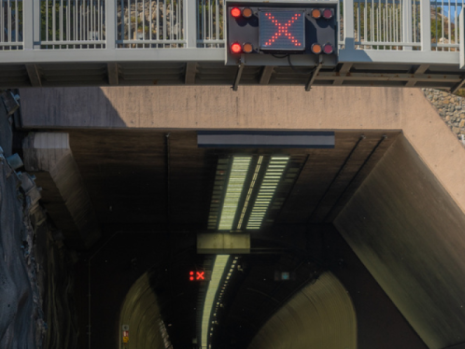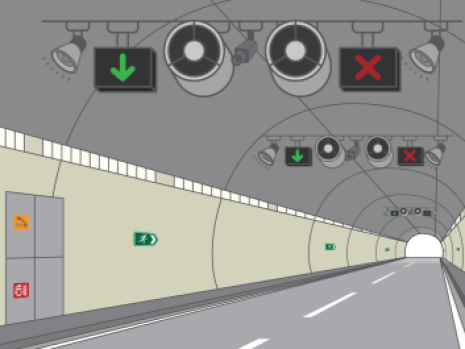There are several safety measures to help people get out of tunnels safely during incidents and to assist the emergency services. Here are some simple tips to help make your journeys in tunnels safer.
How to stay safe while driving in a tunnel
- Keep moving: Unless it's an emergency, don't stop inside the tunnel. It helps keep traffic flowing smoothly.
- Use dipped headlights.
- Stick to the speed limit: Observe all speed limits on the approaches to and through the tunnel – caution these may change.
- Safe distance: Always maintain a safe distance from the vehicle in front of you. For regular cars, leave at least a 2-second gap. Larger vehicles need a 4-second gap for safety.
- Follow directions: Avoid turning or reversing unless instructed to do so by a Police or Traffic Officer. This prevents confusion and keeps everyone safe.
- Stay alert: Be vigilant and watch for any signs like red x signals while driving through the tunnel. Follow any emergency instructions promptly to ensure the safety of yourself and others.
Understanding the red x in tunnels
- Respect the Red X: If you see a lane marked with a Red X, don't drive in it. It's closed for safety reasons, and it's against the law to ignore it.
- Reasons for the Red X: Sometimes, the Red X is used early to help emergency vehicles or guide drivers back onto the motorway from emergency areas. Please make space in traffic so others can move to open lanes.
- Wait for signs: Wait for signs indicating the closed lane is open again. They might show speed limits or when the restriction ends. Even if you've passed a problem, don't use a closed lane as there might be more issues ahead.
What to do if you break down or are involved in an incident in a tunnel?
- Turn on hazard lights: If you have trouble, switch on your hazard lights to signal danger.
- Park safely: Stop your vehicle on the left side and turn off the engine. Keep the key or fob in the ignition so that recovery agents can move your vehicle.
- Be cautious: Watch out for other vehicles. Try to leave your vehicle from the left-side door if it's safe. Passengers should do the same. If you can't leave your vehicle, call 999 for help.
- Use SOS Points: Use emergency phones every 100 meters in the tunnel to ask for help. Stay cautious of traffic and never cross the road.
- Listen and follow: Pay attention to announcements and instructions broadcast. Follow what the tunnel operator tells you.
What to do if there's a fire in the tunnel?
- Smoke or Fire Ahead: If you see smoke or fire in the tunnel ahead, don't enter. Pull over to the left and turn on the hazard lights.
- Evacuation Steps: If there's smoke or fire ahead once you're in the tunnel, stop on the left, turn off the engine, and leave your vehicle. Leave the key of fob in the vehicle. Follow the signs to walk out of the tunnel towards the entrance you used. Wait at the marked evacuation spot outside for help.
- Smoke or Fire Behind: If you spot smoke or fire behind you, keep driving out of the tunnel and don't turn back.
- Vehicle on Fire: Drive out if your vehicle's on fire. If you can't leave the tunnel, stop on the left, turn off the engine, and get out. Follow the evacuation signs to exit the tunnel and wait outside.
- Use SOS Phones: Call for help using the SOS phones at the evacuation spot outside the tunnel.
- Listen and Act: Follow instructions from the tunnel operator through announcements.
- Fire Extinguishers Available: Fire extinguishers are beside emergency panels in the tunnels for use if needed
Related content


